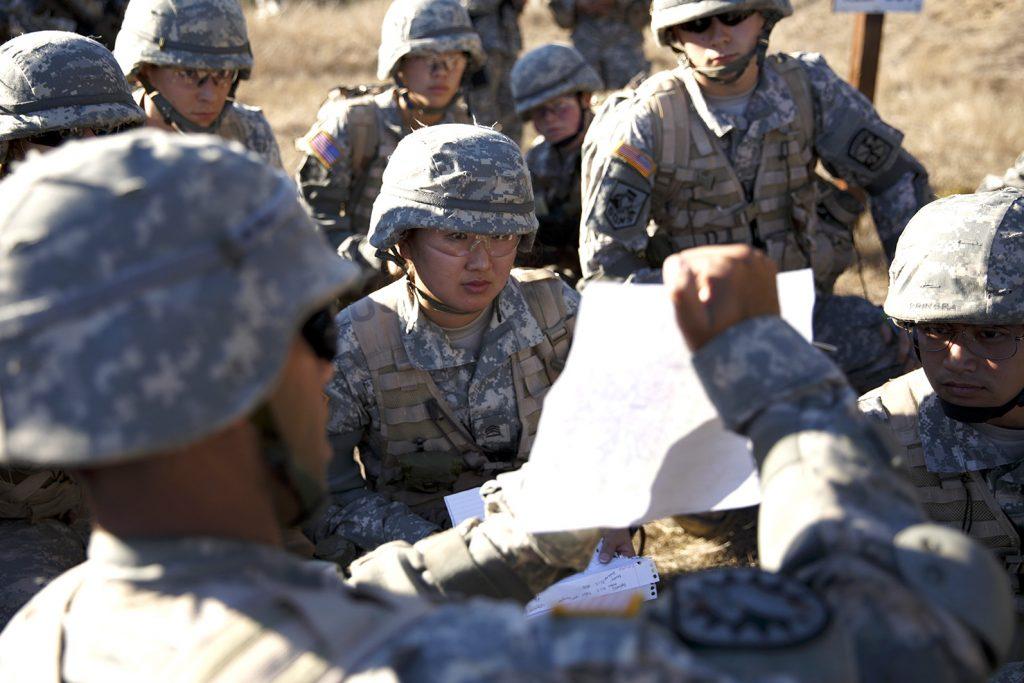Cadets dressed in camouflage lay hidden in thorny bushes, aiming their replica M4 paintball markers at the enemy below. Suddenly, the whirring sound of the bullet-less markers broke the silence, as the cadets shot at the enemy in the cover of the birch trees below. One by one, the opposition fell onto the yellow grass at Camp Tamarancho in Marin County, until the last rebel fell.
“Index is called!” shouted Darren Singh, commanding officer for the leadership development exercise in USF’s Army Reserve Officer’s Training Corps.
“It’s over; it’s over – it’s real life now,” said University of San Francisco MSI sophomore cadet, Renia Pitre.
The tactical mission was part of USF’s Army ROTC program, which is the host school for San Francisco county. Army ROTC Dons Battalion, which was founded in 1936, trains students to become commissioned officers in the U.S. Army.
“We try to make it as real life (a) situation as possible,” said SF State senior and ROTC Public Affairs Officer Ryan Kim.
Schools such as SF State, Academy of the Arts University, Sonoma State University and other local junior colleges are allowed to participate in the program through cross-enrollment. Of the 73 students currently in the program, 21 are SF State students, according to Lt. Col. Sean Williams, a professor of military science at USF.
[slideshow_deploy id=’69532′]
“Once a cadet enrolls into military science, we don’t distinguish them by school – they are all a cadet or a student like anyone else in the class,” Williams said.
The ROTC classes consist of two parts: academic classes and a three-hour lab period. Within the lab periods, cadets learn basic military training such as land navigations, drills and patrolling skills. The academic classes cover subjects including military law, military leadership and military history. The program also includes physical training to improve a cadet’s physical fitness.
“This program is focused on peer leadership and it’s peer-run – we run the program ourselves,” said SF State senior and Battalion Logistics Officer Darren Singh. “The only real thing our cadre members do for us is instructions and guidance. They are there to give us the wisdom and guidance, because they’ve been officers in the military for years and years.”
Outside of the classroom, ROTC members usually spend two and a half hours at Camp Tamarancho, where they form two squads – one in uniform, one in civilian clothing – and attack each other in the battlefield until the mission is completed, according to Kim.
“(It’s) just one huge mission,” Singh said. “An American infantry platoon would react to an enemy, but of course, we’re cadets, so it doesn’t go off according to plan. But that’s what it is – it’s a leadership development exercise.”
The first two years of the ROTC program, cadets focus on basic soldier training, according to Singh. Midway through the program, a cadet is assessed heavily on his or her leadership skills in commanding a squad and is required to complete a month-long Cadet Leadership Course at Fort Knox, Kentucky. When a cadet reaches their senior year, they learn about the administrative training of the Army, such as the military code of justice and the Army policies, then graduate as a commissioned officer with their degree.
“The army, and military in general, is all about learning efficiency,” said Miles Popplewell, an MSIII junior and master’s student studying international relations at SF State. “It’s all about learning leadership skills, and it’s also big on problem solving.”
Kim said cadets are not obligated to sign a contract with the U.S. Army during their first two years in the program. Once they have reached their junior year and are fully qualified, they are required to sign a contract. Upon completion of the program, they can serve as a commissioned officer in the U.S. Army either part-time or full-time.
“My primary passion was English and writing, and it still is, but I’ve always been kind of service-minded,” Singh said. “ROTC was kind of a good midway point where I didn’t have to enlist – I could be an officer; I could be in a leadership role instead of following orders all the time. I fell in love with the program. It was a perfect fit for me.”






